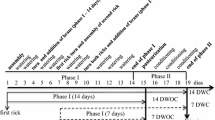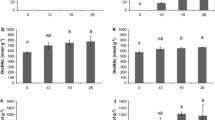Abstract
Agaricus blazei Murrill is usually cultivated using the same biphasic composting method employed for A. bisporus. Because cultivation of A. blazei on traditional A. bisporus composts poses some disadvantages, non-composted substrates were studied for A. blazei cultivation. Mycelial growth rate and productive performance of A. blazei were evaluated on substrates containing sunflower seed hulls, Pleurotus spp. spent mushroom substrate, or their combination, in the absence or in the presence of different supplements (vermicompost, peat or brewery residues). Substrates were prepared by initially soaking them and then they were sterilized (1 atm for 120 min). In addition, each substrate’s degradation was measured after cultivation by obtaining the lignin, cellulose, hemicellulose, organic matter, total fiber, ash, carbon and nitrogen contents before spawn-run and at the end of two flushes of A. blazei. The cultivation of A. blazei on non-composted substrates is possible and with a low rate of contamination when using the spent mushroom substrate as the main component or combined 50:50 with sunflower seed hulls. In addition, the best yields were obtained on those substrates containing spent Pleurotus mushroom substrate with supplements and those mixtures with sunflower seed hulls and vermicompost. These yields were similar to those reported on composted substrates. Substrate changes in composition measured at the end of two flushes indicate that the lignin-hemicellulose fraction was preferentially used and that the substrates exhibiting the best yield showed greater biodegradation of lignin-hemicellulose fraction than the others did.
Similar content being viewed by others
References
Adams JDW, Frostick LE (2008) Investigating microbial activities in compost using mushroom (Agaricus bisporus) cultivation as an experimental system. Bioresour Technol 99:1097–1102
Andrade MCN, Kopytowski Filho J, Minhoni MTA, Coutinho LN, Figueiredo MB (2007) Productivity, biological efficiency, and number of Agaricus blazei mushrooms grown in compost in the presence of Trichoderma sp. and Chaetomium olivacearum contaminants. Braz J Microbiol 38:243–247
Arancon NQ, Edwards CA, Bierman P (2006) The influence of vermicompost applications to strawberries. Part 2. Changes in soil microbiological, chemical and physical properties. Bioresour Technol 97:831–840
Atiyeh RM, Lee S, Edwards CA, Arancon NQ, Metzger JD (2002) The influence of humic acids derived from earthworms-processed organic wastes on plant growth. Bioresour Technol 84:7–14
Bechara MA, Heinemann P, Walker PN, Romaine CP (2006) Evaluating non-composted grain substrates for the production of Agaricus bisporus and A. blazei mushrooms. ASAE Paper No. 067089. ASABE, St. Joseph
Chang ST, Quimio TH (1982) Tropical mushrooms: biological nature and cultivation methods. The Chinese University Press, Hong Kong, p 493. ISBN 9622012647
Coello Castillo MM (2006) Uso de Scytalidium thermophilum para el cultivo semi-comercial de Agaricus spp. MSc Thesis, Instituto Politécnico Nacional, Santa Cruz Xoxocotlán, Oaxaca, México, p 78
Conghos MM, Aguirre ME, Santamaría RM (2006) Sunflower hulls degradation by composting with different nitrogen sources. Environ Technol 27:969–978
Curvetto N, Figlas D, Devalis R, Delmastro S (2002) Sunflower seed hulls as substrate for the cultivation of shiitake (Lentinula edodes) mushrooms. HortTechnology 12:652–655
Curvetto N, González Matute R, Figlas D, Delmastro S (2004) A simple production protocol for Pleurotus ostreatus on SSH-based substrate. In: MushWorld (ed) Mushroom growers’ handbook. I: oyster mushroom cultivation. Heineart Inc., Korea, pp 101–106. ISSN 1739 1377
Duns GJ, Rinker DL, King L, Ripley BD, Alm G (2004) Comparisons of odor emissions from mushroom substrate prepared by traditional windrow and forced aeration composting methods using organoleptic and analytical chemical methods of odor assessment. Mushroom News 52(8):6–24
Ferreira da Eira A (2003) Cultivo do cogumelo medicinal Agaricus blazei (Murrill) ss. Heinemann ou Agaricus brasiliensis (Wasser et al.). Aprenda Fácil, p 398. ISBN: 85-88216-44-2
Figlas D, González Matute R, Curvetto N (2007) Cultivation of culinary-medicinal Lion’s Mane mushroom Hericium erinaceus (Bull.: Fr.) Pers. (Aphyllophoromycetideae) on substrate containing sunflower seed hulls. Int J Med Mushrooms 9:67–73
Galli L (2007) Produção de inóculo e de basidiomas de Agaricus brasiliensis ABL 97/11 em diferentes substratos. PhD Thesis, Faculdade de Agronomia Eliseu Maciel, Universidade Federal de Pelotas, Brasil, p 168
García BS, Royse DJ, Sánchez JE (2005) Vermicompost in substrate and casing formulas for the production of brown Agaricus bisporus. In: Tan Q, Zhang J, Chen M, Cao H, Buswell JA (eds) Proceedings of the 5th international conference on mushroom biology and mushroom products, Shanghai, pp 243–248
González Matute R (2009) Biotransformación de cáscara de girasol para la producción del hongo comestible y medicinal Agaricus blazei y obtención de subproductos de valor económico. PhD Thesis, Facultad de Agronomía, Universidad Nacional del Sur, Bahía Blanca, Argentina, p 228
González Matute R, Figlas D, Devalis R, Delmastro S, Curvetto N (2002) Sunflower seed hulls as a main nutrient source for cultivating Ganoderma lucidum. Micol Aplicada Int 14(2):19–24
González Matute R, Figlas D, Curvetto N (2010) Cultivo de Agaricus bisporus usando un sistema a pequeña escala para el compostado de mezclas a base de cáscara de semilla de girasol. In: Red Latinoamericana de Hongos Comestibles y Medicinales: Producción, Desarrollo y Consumo (ed) Hacia un Desarrollo Sostenible del Sistema de Producción-Consumo de los Hongos Comestibles y Medicinales en Latinoamérica: Avances y Perspectivas en el Siglo XXI, Mexico, pp 111–123. ISBN 970-9752-01-4
Iiyama K, Stone BA, Macauley BJ (1994) Compositional changes in compost during composting and growth of Agaricus bisporus. Appl Environ Microbiol 60(5):1538–1546
Kerrigan RW (2005) Agaricus subrufescens, a cultivated edible and medicinal mushroom, and its synonyms. Mycologia 97(1):12–24
Kerrigan RW (2007) Inclusive and exclusive concepts of Agaricus subrufescens Peck: a reply to Wasser et al. Int J Med Mushrooms 9(1):79–84
Kopytowski Filho J, Minhoni MTA (2004) C/N ratio on yield of Agaricus blazei Murrill ss. Heinemann. In: Romaine CP (ed) Science and cultivation of edible fungi. Penn State University, Philadelphia, pp 213–220
Mamiro DP, Royse DJ (2008) The influence of spawn type and strain on yield, size and mushroom solids content of Agaricus bisporus produced on non-composted and spent mushroom compost. Bioresour Technol 99:3205–3212
Mee HM (1978) Mushroom composting. US Patent No. 4,127,964
Nelson DW, Sommers LE (1996) Total carbon, organic carbon, and organic matter. In: Sparks DL, Bartels JM (eds) Methods of soil analysis: chemical methods, part 3, SSSA Book Series number 5. Madison, pp 961–1009
Nwanze PI, Khan AU, Ameh JB, Umoh VJ (2005) The effects of the interaction of various oil types and rates on the mycelial wet and dry weights of Lentinus squarrosulus (Mont.) Singer and Psathyrella atroumbonata Pegler in submerged liquid cultures. Afr J Biotechnol 4:620–626
Peil RMN (1992) Cultivo de cogumelos Agaricus bisporus (Lange) Imbach in vitro e “in natura” em diferentes substratos. MSc Thesis, Faculdade de Agronomia Eliseu Maciel, Universidade Federal de Pelotas, Brasil, p 127
Sampedro I, Cajthaml T, Marinari S, Petruccioli M, Grego S, D’Annibale A (2009) Organic matter transformation and detoxification in dry olive mill residue by the saprophytic fungus Paecilomyces farinosus. Process Biochem 44:216–225
Sánchez JE, Royse DJ (2001) Adapting substrate formulas used for shiitake for production of brown Agaricus bisporus. Bioresour Technol 77:65–69
Sharma HSS (1991) Biochemical and thermal analysis of mushroom compost during preparation. In: Maher MJ (ed) Science and cultivation of edible fungi. Balkema, Rotterdam, pp 169–179
Stijve T, Amazonas MAL (2001) Agaricus blazei Murrill, un nouveau champignon gourmet et medicament qui nous vient du Brésil. Misc Mycol Mons 69:41–47
Till O (1962) Cultivation of mushrooms on sterile substrate and reutilization of spent compost. Mushroom Sci 5:127–133
Van Soest PJ (1963) Use of detergents in the analysis of fibrous feeds. II. A rapid method for the determination of fiber and lignin. J Assoc Off Chem 46:829–835
Van Soest PJ (1967) Development of a comprehensive system of feed analysis and its application to forages. J Anim Sci 26:119–128
Van Soest PJ, Robertson JB (1980) Systems of analysis for evaluating fibrous feeds. In: Pigden WJ, Balch CC, Graham M (eds) Standardization of analytical methodology for feeds. International Development and Research Center, Ottawa
Wardle KS, Schisler LC (1969) The effects of various lipids on growth of mycelium of Agaricus bisporus. Mycologia 61(2):305–314
Wasser SP, Didukh MY, de Amazonas MAL, Nevo E, Stamets P, Eira AF (2002) Is a widely cultivated culinary medicinal Royal Sun Agaricus (the Himematsutake mushroom) indeed Agaricus blazei Murrill? Int J Med Mushrooms 4:267–290
Wasser SP, Didukh MY, Amazonas MAL, Nevo E, Stamets P, Eira AF (2005) Is a widely cultivated culinary-medicinal royal sun Agaricus (Champignon do Brazil, or the himematsutake mushroom) Agaricus brasiliensis S. Wasser et al. indeed a synonym of A. subrufescens peck? Int J Med Mushrooms 7:507–511
Acknowledgments
This research was supported by the Consejo Nacional de Investigaciones Científicas y Técnicas (CONICET), the Comisión de Investigaciones Científicas de la Provincia de Buenos Aires (CIC, La Plata, Argentina) and Universidad Nacional del Sur (UNS, Bahía Blanca, Argentina). We also thank Ricardo Devalis for his helpful technical assistance.
Author information
Authors and Affiliations
Corresponding author
Rights and permissions
About this article
Cite this article
González Matute, R., Figlas, D. & Curvetto, N. Agaricus blazei production on non-composted substrates based on sunflower seed hulls and spent oyster mushroom substrate. World J Microbiol Biotechnol 27, 1331–1339 (2011). https://doi.org/10.1007/s11274-010-0582-5
Received:
Accepted:
Published:
Issue Date:
DOI: https://doi.org/10.1007/s11274-010-0582-5




